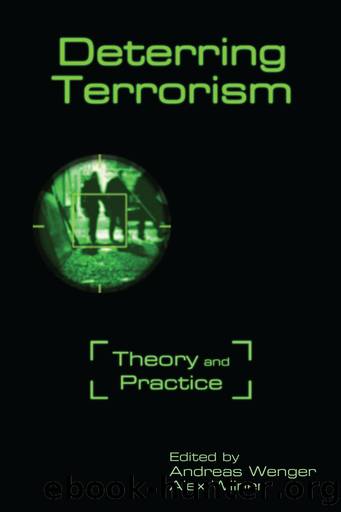Deterring Terrorism by Wenger Andreas;Wilner Alex;

Author:Wenger, Andreas;Wilner, Alex;
Language: eng
Format: epub
Publisher: Stanford University Press
Published: 2012-08-15T00:00:00+00:00
Figure 7.4. WMD terrorism and strategies of denial
CONCLUSION
This chapter has suggested an application of denial strategies designed to negate the objectives and rationale for WMD terrorism. The question remains, however, as to whether denial strategies constitute deterrence, or are simply considered tools in defending oneself against WMD terrorism. We argue that as you build from the tactical through the operational and to the strategic level, as you begin to attack and deny terrorist strategy and the foundation of legitimacy upon which it is based, that elements of deterrence are achieved. The terrorist leadership becomes convinced that WMD terrorism cannot fulfill its strategy and ideological goals; this amounts to denial of its theory of victory. This constitutes net effect deterrence by denial as envisioned but never fully enacted by the forefathers of deterrence. Further, if you reject that argument and insist that this can only be called denial actions in defense against WMD terrorism, the practical effects are nonetheless the same: muting and altering the threat, with net positive outcomes likely in the form of avoided or mitigated WMD attacks.
Our conclusions, then, are first that deterrence applied to WMD terrorism may not be the answer, but it certainly is an answer and is worth further consideration and analysis. Second, we conclude that terrorist organizations at the mature phase of development and at a level of sophistication that might enable systematic WMD terrorism are deliberate, internally rational entities, and that their core leadership and support elements are likely vulnerable to coercive influence. Third, we note that there may be at least limited roles for traditional, punishment-based deterrence strategiesâparticularly against state sponsors and enablersâbut that these levers amount to denial of support to the terrorists. Fourth, we assert that there are critical dynamics, processes, and players within the terrorist organization, that these elements can be mapped as relevant to WMD terrorism, and that denial targets and layered strategies can be identified and designed toward the creation of a net effect of deterrence by denial of âvictoryâ in the mind of the terrorist leadership. Fifth, these strategies are applicable and their WMD denial effects attainable even when applied within active campaigns of non-WMD terrorism and counterterrorism. Sixth, we argue that these denial efforts, even absent the posited net deterrence effect, constitute sound elements of combating WMD terrorism. Seventh, we see deterrenceâand particularly deterrence by denialâas a fertile area of continuing inquiry as applied to terrorism beyond just that applied here to address the WMD threat. Finally, we conclude that piecemeal efforts at the national and international levels may be individually positive steps against WMD terrorism, but orchestrated synergies within a deliberate denial framework can magnify the individual effects of these efforts toward net effects that can indeed act to deter terrorism in at least some forms and directions.
NOTES
1. The most widely accepted definition of âWMDâ is probably that adopted by the United Nations in 1948: âAtomic explosive weapons, radio-active material weapons, lethal chemical and biological weapons, and any weapons . . . which have
Download
This site does not store any files on its server. We only index and link to content provided by other sites. Please contact the content providers to delete copyright contents if any and email us, we'll remove relevant links or contents immediately.
The Secret History by Donna Tartt(18188)
The Social Justice Warrior Handbook by Lisa De Pasquale(11957)
Thirteen Reasons Why by Jay Asher(8461)
This Is How You Lose Her by Junot Diaz(6451)
Weapons of Math Destruction by Cathy O'Neil(5841)
Zero to One by Peter Thiel(5498)
Beartown by Fredrik Backman(5369)
The Myth of the Strong Leader by Archie Brown(5243)
The Fire Next Time by James Baldwin(5024)
How Democracies Die by Steven Levitsky & Daniel Ziblatt(4966)
Promise Me, Dad by Joe Biden(4911)
Stone's Rules by Roger Stone(4866)
100 Deadly Skills by Clint Emerson(4695)
A Higher Loyalty: Truth, Lies, and Leadership by James Comey(4556)
Rise and Kill First by Ronen Bergman(4548)
Secrecy World by Jake Bernstein(4393)
The David Icke Guide to the Global Conspiracy (and how to end it) by David Icke(4386)
The Farm by Tom Rob Smith(4329)
The Doomsday Machine by Daniel Ellsberg(4250)
